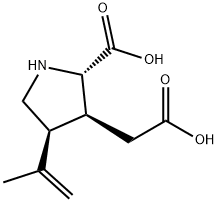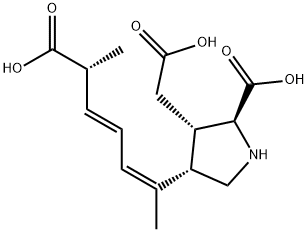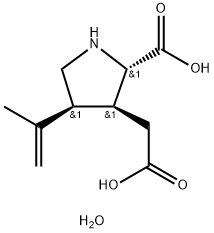PRODUCT Properties
| Melting point: | 253-254 C |
| alpha | D24 -14.8° (c = 1.01) |
| Boiling point: | 353.22°C (rough estimate) |
| Density | 1.2177 (rough estimate) |
| refractive index | 1.4368 (estimate) |
| storage temp. | Keep in dark place,Sealed in dry,2-8°C |
| solubility | H2O: soluble |
| form | White to off-white solid. |
| pka | 2.03±0.60(Predicted) |
| color | White |
| optical activity | -14.824 (H2O) |
| Water Solubility | Soluble to 25 mM in water |
| Stability: | Stable for 1 year from date of purchase as supplied. Solutions in distilled water may be stored at -20° for up to 3 months. |
| InChI | InChI=1S/C10H15NO4/c1-5(2)7-4-11-9(10(14)15)6(7)3-8(12)13/h6-7,9,11H,1,3-4H2,2H3,(H,12,13)(H,14,15)/t6-,7+,9-/m0/s1 |
| InChIKey | VLSMHEGGTFMBBZ-OOZYFLPDSA-N |
| SMILES | N1C[C@H](C(C)=C)[C@H](CC(O)=O)[C@H]1C(O)=O |
| EPA Substance Registry System | 3-Pyrrolidineacetic acid, 2-carboxy-4-(1-methylethenyl)-, (2S,3S,4S)- (487-79-6) |
Description and Uses
Kainic acid (487-79-6) is a conformationally restricted glutamate analog which acts as a selective agonist at kainate receptors. CNS stimulant and neurotoxin. Kainic acid is a classic neuroexcitatory agent for induction of seizures in laboratory animals (typical dose 10-30 mg/kg).
(-)-α-Kainic Acid is a naturally occurring neuroexcitatory chemical that is an selective agonist for a subtype of ionotropic glutamate receptor. Administration of (-)-α-Kainic Acid has been shown to increase production of reactive oxygen species, mitochondrial dysfunction, and apoptosis in neurons in many regions of the brain, particularly in the hippocampal subregions and in the hilus of dentate gyrus.
Safety
| Symbol(GHS) |  GHS07 |
| Signal word | Warning |
| Hazard statements | H302-H312-H332 |
| Precautionary statements | P261-P264-P270-P271-P280-P301+P312-P302+P352-P304+P340-P330-P363-P501 |
| Hazard Codes | Xn |
| Risk Statements | 20/21/22 |
| Safety Statements | 22-24/25-36 |
| WGK Germany | 3 |



